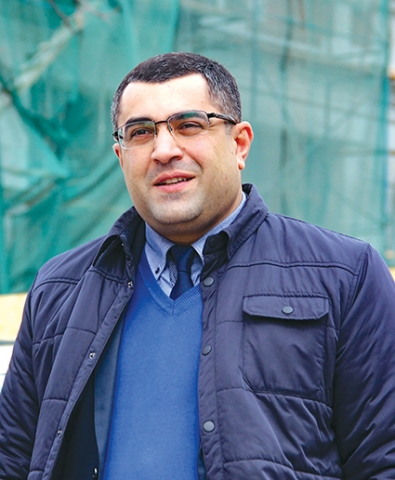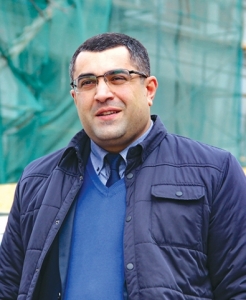Tbilisi Development Fund, Making Tbilisi Shine
Giorgi Baidarashvili spoke to Georgia Today about the work of the Fund.
Please summarize 2015: Which are the most important projects? What was the main direction of work for the Fund?
I have been Head of the Fund since July 1st, 2015, therefore it makes more sense to summarize the period over the last six months.
The second half of 2015 has been marked by very important initiatives and changes for the Fund, there are three main aspects: new projects, organizing and implementing the planning for rehabilitation of certain areas in 2016 and institutional development of the Fund.
Within a limited timeframe, in the second half of 2015, extremely important projects have begun in the historical part of the city and in terms of touristic development. The rehabilitation projects of the Wine Rise, Gudiashvili Square and historical buildings in the second part of Agmashenebeli will become a foundation for the increase of social and economic welfare of the citizens of Tbilisi.
The second direction, which envisages preparation of projects for 2016, started, also in rapid mode, in September and October. The planning of the rehabilitation of up to 45 houses located in the second part of Agmashenebeli Avenue, will be finished by the end of this year. Moreover, preparation works will be ready for 15 historical monuments and/or public infrastructural projects. These will serve as the basis for a very loaded yet correct working plan for the Fund next year.
The same year, based on the Gudiashvili Square conservation, we plan to start working on plans for the rehabilitation of those addresses in the most severe state, and also to make the plans for works that should be carried out on the second part of Agmashenebeli Avenue, which will clarify what further decisions need to be taken.
The third direction, which started in August, concerns organizational and methodological development of the Fund as well as personnel management:
1. At the beginning of November, a completely new organizational structure was introduced in the Fund, developed by the employees, together with consulting firm Synergy Group.
2. The existing scheme of human resource distribution has been rethought, with consideration of abilities and qualifications. Moreover, the Fund has been recruiting new employees in an on-going process.
The purpose of the Fund has been clearly defined and specified and envisions preserving the historical appearance of Tbilisi and increasing the value of real estate. The renewed structure of the Fund has been built on this principle and is comprised of the following three permanent strategy action plans:
1. Define the opportunities and necessities related to preserving the historical appearance of the city and increasing the value of properties (not only in monetary terms).
2. Plan correct ways of using these opportunities for the benefit of the city.
3. Realize these opportunities in a qualified, rapid and correct manner.
The activities of the Fund have always been and will continue to be related to improving the touristic, economic and social potential of the city. In the areas where the Fund is carrying out its activities, the visual side of the city is improved, the condition of monuments, the number of tourists and visitors is increasing, and the value of the property and the price of its usage (rent). All this is the basis for the improved welfare of our citizens.
Which rehabilitation projects involving unique historic houses would you distinguish?
One of the best examples in this regard is No.36, D. Agmashenebeli Avenue, with its wonderfully painted entrance. The residential block on Shalva Dadiani Street, No.32-34 is also very important as it is considered as the oldest building in the historical district of Tbilisi. Its rehabilitation is planned for 2016.
The main action area of the Fund includes up to about 2000 monuments, with 18th century monuments on Gudiashvili Square, buildings on Agmashenebeli and Orbeliani Square among them. The processes for planning the rehabilitation of these has started. We hope that we will be able to rehabilitate the ones that are in the most severe state.
In this regard, in order to determine the priorities correctly, with the help of the company “Geography,” the Fund carried out a unique project for accounting and evaluating the conditions of historical monuments and for determining the right necessary works. Such thorough study and evaluation of monuments for the planning of rehabilitation, restoration, and conservation has never been carried out Tbilisi. This research is a clear and correct action framework-decision of the Fund for the following 3-5 years, made in order to use those unique opportunities that exist due to the many historical buildings, for the benefit of citizens, Tbilisi and the country.
Tell us about any difficulties the Fund faces. How does the fund overcome them?
Claiming that we and the City Hall do not face barriers, when works of this scope should necessarily be carried out, would be false. The most important problems, which we think we will be able to overcome through stable, continuous communication, are the following:
First of all the attitude of citizens, especially the ones who own the monuments and who have stereotypes regarding their real estate. It is incorrect to think that the border of your house is only your door step, when you do not care what happens beyond it, when you are not interested in its constructional, visual or hygienic state. It is also incorrect to think that only the government is responsible for preserving and developing the property, which is often more than 100 years old. When the attitude of the population is that they should necessarily gain something from the project, it becomes very difficult for the Fund to carry out the works at the relevant pace, to keep up with the pace with which the historical monuments are damaged daily.
Second is the attitude and stereotypes of business representatives towards historical monuments and how they should be used. Today, interest towards historical monuments in the Old city is unhealthy and rather short-term. Most of those who are interested in monuments perceive them as a problem if they want to build something and/or purchase it; they focus on demolishing the monument and constructing a bigger building in its place. While this attitude exists, the pace of rehabilitation of historical areas will always be slow. Throughout the next years, the Fund will try to change existing stereotypes for the benefit of the Old city.
The third is that the legal regulations need to be improved. Borders need to be determined for the Fund, the government in general and business, which instead of hindering will support saving the monuments and using them in the correct way. Without this they will never have anyone responsible for their preservation.
The Fund will not spare itself to make a complex analysis in which the sequence all the necessary works should be carried out in order to renew-preserve and conserve historical monuments, and to reveal incorrect, outdated legal barriers, as well as vacuums, and suggest opportunities for correction. Afterwards, we will develop initiatives about changes and try to improve the situation in the legislation for managing the historical monuments.
Tell us about new projects for the upcoming year
The main concentration in 2016 will be on rehabilitation of the second part of Agmashenebeli Avenue and the main part of Gudiashvili Square.
Also, finishing the majority of rehabilitation works within various separate projects that have started in 2015, with all addresses on the Wine Rise among them, Khetagurov’s House-Museum, Medicine Museum, various places in Kvemo Kala, and residential buildings on Tumaniani and Betlemi streets
At the end of the first half of 2016, the planning of next year’s projects will begin, for which the preparation project on concepts of development of the Pirosmani-Constitution-Kargareteli-Agmashenebeli-Orbeliani avenues will be finished by the end of 2015. This project will determine the opportunities of development in the stated areas, and the Fund will use them in the following 2-3 years.
What is the importance of tourism for the rehabilitated old city? What about the charm and attraction of the old city in general?
Deriving from the historicity of Tbilisi, it is extremely interesting in terms of tourism and it will become even more appealing if we are able to foresee the target area of exactly what touristic flow Tbilisi can gain in the next 3-5 years.
It will be difficult to use the touristic potential of Tbilisi correctly if we don’t identify the potential touristic streams and stimulate the creation of interesting attraction spots for them. In future, the Fund will try to develop interesting routes for potential tourists based on this principle with all elements: creating interesting connections between existing routes, creating new attraction points, and supporting the development of Tbilisi by promoting it together with the relevant state and private tour operators.
What is the benefit of development of the capital’s historic area?
This is a unity of decisions, developed based on detailed research of up to 2200 buildings in the historic part of Tbilisi and derived from evaluating the scope of influence these can have on developing the city. The concept determines in which sequence the Fund should work on saving the historic-cultural monuments. Specifically, it determines which monuments the Fund should work on out of all 1700 monuments. What is most interesting is that the prioritization of working on these monuments is determined not only based on the necessity of saving the monument, but also on what effect saving it have on the development of the street, district, region and the city, as well as in terms of touristic-social and commercial-economic aspects.
Therefore, in terms of objectivity, the Fund has very clear action priorities for organizing the processes of rehabilitation of historic-cultural monuments in the upcoming 2-3 years.
Which of the ongoing projects would you single out?
All of them are important, so it is difficult to choose a single one. In short, it is very important to connect the already rehabilitated parts of Tbilisi with touristic and commercial points and the parts that are interesting in terms of social life with each other.
In this regard we plan to connect Pirosmani Street, which is connected to two large shopping centers in the city center – Tbilisi Central and Kavasla, with a highly important transportation hub (Railway Square), to the already partly rehabilitated Agmashenebeli Avenue via Constitution-Kargareteli Streets. Later, after rehabilitating this part of Agmashenebeli, Dry Bridge and Orbeliani Squares and the rehabilitated Gudiashvili Square will be connected with the rehabilitated Kvemo Kala. It will be logical to rehabilitate the roads leading to the Sameba Fortress and interconnecting the stated enormous rehabilitated touristic zone with it as Sameba represents a critical attraction for the city, together with many other buildings. While visiting Tbilisi, a tourist will by all means find himself here. Wine Rise is part of this route, which is why its rehabilitation is important within this route and not as a separate unity of addresses.
How does your ideal Tbilisi look?
It would be a city loved by people, in which each street, house, garden, square, entrance or elevator is an object that is handled just like our own homes... A place where people care for their city, respect each other and our guests.











